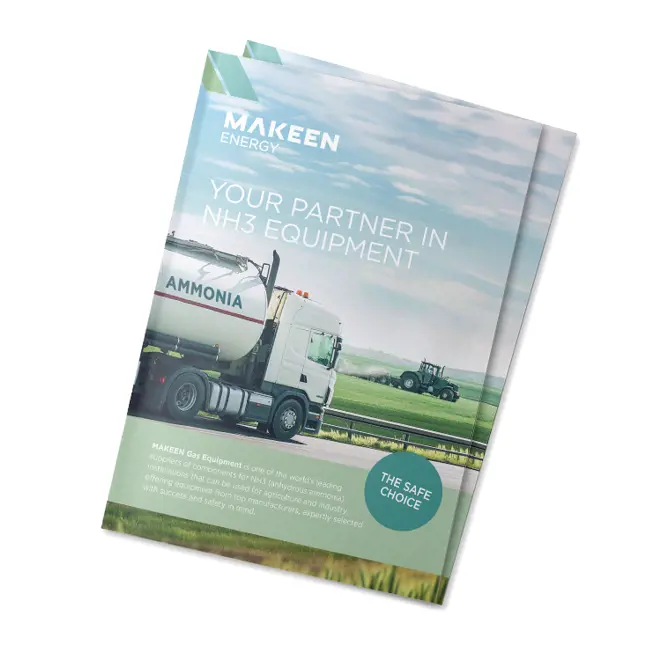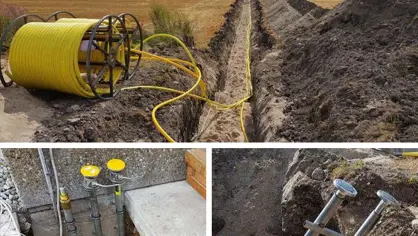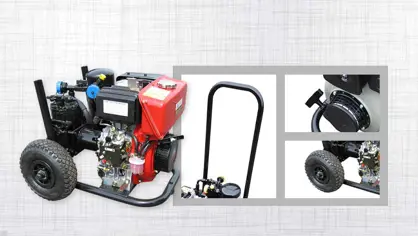NH3 is becoming even more attractive due to its Power-to-X (PTX) potential when produced using electricity from renewable sources. And new applications are on their way to reduce CO2 footprint in many industries.
NH3, often called anhydrous ammonia, is a molecule consisting of nitrogen and hydrogen. It’s a colourless gas or liquid with a pungent smell, often compared to the scent of strong household cleaning products. But despite its strong odour, NH3 plays a large role in many modern industries.
You may know it as NH3. If you are a chemist, you could refer to it as hydrogen nitride. Another common name for this gas is anhydrous ammonia (anhydrous meaning “without water”). Therefore, when we talk about anhydrous ammonia, we are referring to pure ammonia in its gas or liquid form with limited water content.
In this article, we want to introduce you to the most common uses of NH3 and how it behaves, as well as the best practices for safe handling of NH3.
Fun fact
The name “ammonia” can be traced back to the ancient Egyptian god Amun, also known as Ammon. When ancient Romans collected ammonium chloride near a temple dedicated to Amun, they named it “sal ammoniacus” – salt of Amun. The gas we know as ammonia or NH3 was named after this due to its similar properties and origin.

Uses for NH3
Agriculture: The most widespread and well-known use for NH3 is undoubtedly its role in modern agriculture. It is a primary ingredient in industrial synthetic fertilisers, providing essential nitrogen to crops. When applied to soil, NH3 absorbs moisture and converts to ammonium ions, which plants can readily uptake.
It is made by combining nitrogen and hydrogen under high temperature and pressure. This method, called the Haber-Bosch process, was developed in the early 1900s and revolutionised global agricultural practices by providing a consistent and abundant source of nitrogen. The nitrogen fertiliser helps plants grow strong and healthy, leading to better yields and more robust harvests.
When a farmer applies NH3 to their soil, it comes in the form of pressurised liquid that turns into vapour when exposed to air. In order to keep the fertiliser from escaping to the atmosphere, farmers will use tools to deliver the NH3 below the soil surface.
Energy: In the energy sector, NH3 is emerging as a potential solution for storing and transporting hydrogen. Since NH3 contains about 17.6% hydrogen, and is easy to transport as a liquid, it presents a viable alternative for hydrogen storage and transport. Unlike pure hydrogen, which requires extremely low temperatures or high pressures to remain in liquid form, ammonia (NH3) can be liquefied under more manageable conditions. This makes it easier and more cost-effective to handle, store, and transport over long distances. Additionally, ammonia’s existing infrastructure and established supply chains can be leveraged, reducing the need for significant new investments. NH3 could therefore play a key role in bridging the gap between production and end-use, facilitating the global transition to hydrogen as a cleaner energy source.
Ammonia as a fuel: Ammonia (NH3) is becoming more and more interesting as an alternative fuel for burners and engines. The flame velocity is slow compared to traditional gaseous fuels but can be used in larger engines, especially in bigger ships. Recent tests with ammonia have shown interesting results as a fuel for gas turbines. The significant advantage with ammonia (NH3) fuel is the complete absence of CO2 emissions from the combustion.
Also in the power plant industry, ammonia (NH3) has been used for removal of nitrous oxide (NOx).
Refrigeration: NH3 has been used in the refrigeration industry for decades as a cost-attractive refrigerant. Its effectiveness and efficiency make it a preferred choice for large industrial refrigeration systems, such as those used in food processing plants.
Fun fact
NH3 is used as a coolant on the International Space Station (ISS). Due to its effectiveness in heat transfer, ammonia is circulated through the station’s external radiators to dissipate heat generated by onboard systems and equipment.
Safety and Handling
While ammonia (NH3) offers many advantages as a solution for hydrogen storage and transport and cleaner energy, handling it safely is crucial. Aside from the strong smell, ammonia can cause severe irritation if it comes into contact with skin or eyes ,and if inhaled it can be fatal. Wearing the right protective gear, like gloves, goggles, and masks, is a must when working with ammonia (NH3).
Additionally, storing and transporting ammonia safely requires specialised equipment. This equipment is designed to keep ammonia in its liquid form, which is achieved by maintaining it under the right pressure and temperature conditions. Without these precautions, the risks associated with ammonia handling can increase, making safety measures a top priority.
Material for NH3 equipment
Since NH3 is a highly reactive substance, it should not come into contact with certain metals like copper, brass, zinc, and their alloys. Instead, equipment for NH3 must be made from compatible materials like carbon steel, stainless steel, or specific types of plastics. Using the correct materials ensures the longevity of the equipment and prevents leaks and equipment failures. This is different from other gasses like LPG that are less reactive and with which there is less concern about corrosion.
Seals and gaskets for NH3 must also be made from materials like Teflon/PTFE, neoprene, or specially designed rubbers that are compatible with ammonia and prevent unwanted chemical reactions.
Fun fact
Historically, ammonia was used in smelling salts. These were once a common remedy for fainting or lightheadedness, as the strong smell could quickly rouse someone to consciousness.
NH3 and Its Hygroscopic Nature
Hygroscopic substances are materials that absorb moisture from the air. This characteristic is significant because it influences how these substances are stored, handled, and used.
NH3 is hygroscopic, meaning it readily absorbs water from its surroundings. When NH3 comes into contact with moisture, it forms ammonium hydroxide (NH4OH), a corrosive substance. This reaction can be useful in some applications but also requires careful management to avoid unwanted consequences. If NH3 absorbs too much moisture, it can become less effective for its intended use and may cause corrosion to storage equipment.
NH3 users also have to take this characteristic into account when setting up their NH3 gas detection system. In its waterless form, NH3 is lighter than atmospheric air, which means it rises to the top. Consequently, you need NH3 gas detectors placed high in the room. But when it absorbs moisture from the air, due to being hygroscopic, the resulting gas becomes heavier than air and descends towards the ground. Therefore, you need to have gas detectors placed both high and low to ensure complete coverage.

Download our brochure for NH3 Ammonia
NH3, or anhydrous ammonia, is a versatile gas that can both be used to feed plants in a field or as an enabler of new, cleaner ways to produce energy. Here you can read about the products and solutions we carry for NH3/Ammonia.
Related pages
Get in touch!
Whether you already know what you need, or you would like the opinion of an expert, we are always ready to help you out.
We carry all the necessary and nice-to-have equipment and accessories for anhydrous ammonia, from NH3 hoses and valves to pumps, compressors, filters and everything in between.




